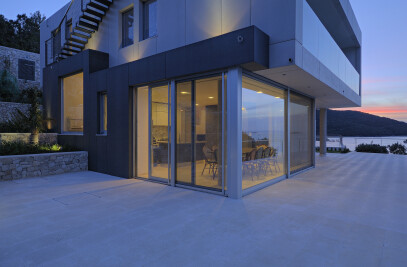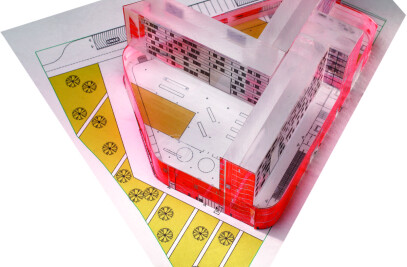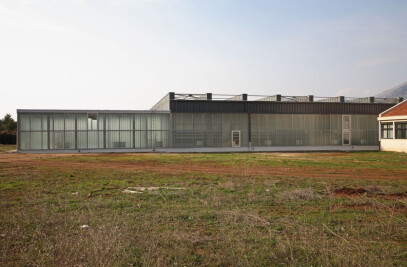Franić’s project generates “its own city-planning” within the borders of the site forms an ample square that slowly rises towards the large “hovering” mass of the Museum which covers the open public space. The monumental dimension of the colonnade is in logical proportion with the scale of the building, but also with the wider context, while the mass covering the porch contributes to dramatic impression. The entire ground floor of the Museum is open to movement, conceived as an extension of the square with the main entrance, restaurant and library, each with a separate access. The glass envelope of the ground floor is not unified, but diversified, which indicates different amenities. It is obvious that the ground floor is the place of transition between public city space and museum halls.This spatial sequence is unambiguously just a preparation and a part of the scenario of movement suspense and experience of the building before entering the exhibition halls. Actually, we are still underneath the museum. Franić formed the body of the building as a geometrically very simple solid of approximately square ground-floor plan, whose cross-section is “folded” in the form of a meander. The configuration of the exhibition space directly emerges from this cascading cross-cut, so that the museum develops in a series of linear stretches vertical to the lateral, meandering profile of the structure.The body of the building is perforated by three vertical intrusions, of which two are also visible from underneath, while one skylight reaches the underground level. In its basic geometric scheme, spatial organization is simple; it is always of the same length on the x-axis, fixed through the matrix of an entirely consequential system within a square grid. In spite of pure Euclidean geometry, the manipulation with x-y-z axes is basically not founded in a logical or immediately readable spatial system, but it is rather a series of specific situations and a variation of relations inside-outside, up-down, and wall-transparency-translucency. Unexpectedly, light is not admitted into the interior from the lateral sides of the meander, but on the contrary, through horizontal stretches that run along the body of the building on the y-axis and vertical intrusions in the z-axis. Although natural light is not zenithal, it always reaches the interior indirectly, through interstices, atriums, and stretches set high above the ground. The exhibition space is introvert and directed at the exhibits, although the outer space is not entirely excluded from the overall impression.Roof terraces are also accessible through two large exterior stairs that can also function as open auditoriums. Exhibition spaces are not articulated either as a classical series of “white cubes” or as entirely open, fluid space, but rather as a series of relatively large halls of different configurations, divided into subspaces specifically adapted to micro-situations of the permanent display. The lateral sides of the meander are not intended for exhibitions, so that in the western part, along the large glass wall, an informal “rest area” is set up. The eastern stretch is occupied by offices and other auxiliary rooms. Like programmed mini-towers, two vertical blocks with autonomous usage routines rise through the core of the structure: the block with a restaurant that stretches from the ground floor over the first floor to the roof terrace and the block that contains the library.
Products Behind Projects
Product Spotlight
News

Fernanda Canales designs tranquil “House for the Elderly” in Sonora, Mexico
Mexican architecture studio Fernanda Canales has designed a semi-open, circular community center for... More

Australia’s first solar-powered façade completed in Melbourne
Located in Melbourne, 550 Spencer is the first building in Australia to generate its own electricity... More

SPPARC completes restoration of former Victorian-era Army & Navy Cooperative Society warehouse
In the heart of Westminster, London, the London-based architectural studio SPPARC has restored and r... More

Green patination on Kyoto coffee stand is brought about using soy sauce and chemicals
Ryohei Tanaka of Japanese architectural firm G Architects Studio designed a bijou coffee stand in Ky... More

New building in Montreal by MU Architecture tells a tale of two facades
In Montreal, Quebec, Le Petit Laurent is a newly constructed residential and commercial building tha... More

RAMSA completes Georgetown University's McCourt School of Policy, featuring unique installations by Maya Lin
Located on Georgetown University's downtown Capital Campus, the McCourt School of Policy by Robert A... More

MVRDV-designed clubhouse in shipping container supports refugees through the power of sport
MVRDV has designed a modular and multi-functional sports club in a shipping container for Amsterdam-... More

Archello Awards 2025 expands with 'Unbuilt' project awards categories
Archello is excited to introduce a new set of twelve 'Unbuilt' project awards for the Archello Award... More

























